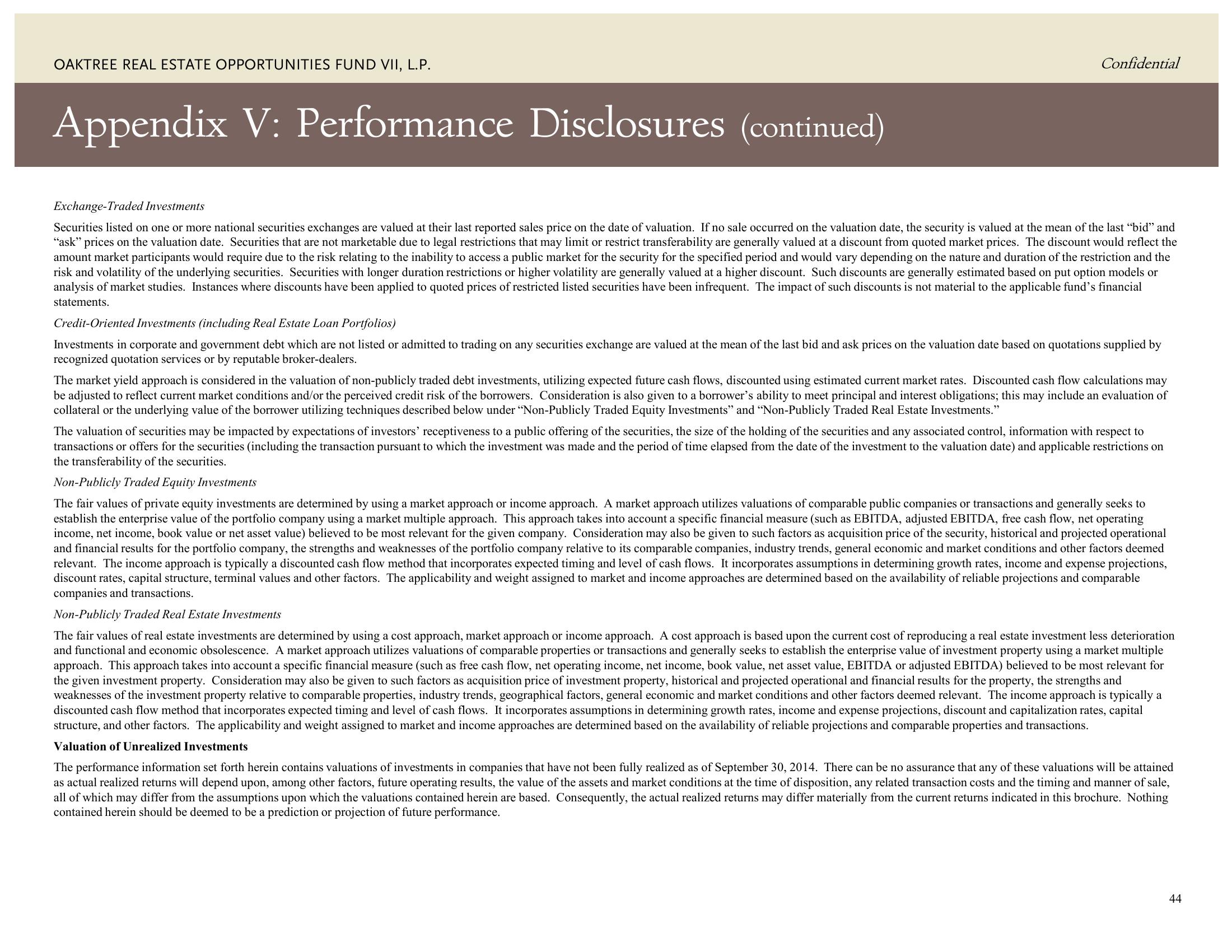Oaktree Real Estate Opportunities Fund VII, L.P.
OAKTREE REAL ESTATE OPPORTUNITIES FUND VII, L.P.
Appendix V: Performance Disclosures (continued)
Confidential
Exchange-Traded Investments
Securities listed on one or more national securities exchanges are valued at their last reported sales price on the date of valuation. If no sale occurred on the valuation date, the security is valued at the mean of the last "bid" and
"ask" prices on the valuation date. Securities that are not marketable due to legal restrictions that may limit or restrict transferability are generally valued at a discount from quoted market prices. The discount would reflect the
amount market participants would require due to the risk relating to the inability to access a public market for the security for the specified period and would vary depending on the nature and duration of the restriction and the
risk and volatility of the underlying securities. Securities with longer duration restrictions or higher volatility are generally valued at a higher discount. Such discounts are generally estimated based on put option models or
analysis of market studies. Instances where discounts have been applied to quoted prices of restricted listed securities have been infrequent. The impact of such discounts is not material to the applicable fund's financial
statements.
Credit-Oriented Investments (including Real Estate Loan Portfolios)
Investments in corporate and government debt which are not listed or admitted to trading on any securities exchange are valued at the mean of the last bid and ask prices on the valuation date based on quotations supplied by
recognized quotation services or by reputable broker-dealers.
The market yield approach is considered in the valuation of non-publicly traded debt investments, utilizing expected future cash flows, discounted using estimated current market rates. Discounted cash flow calculations may
be adjusted to reflect current market conditions and/or the perceived credit risk of the borrowers. Consideration is also given to a borrower's ability to meet principal and interest obligations; this may include an evaluation of
collateral or the underlying value of the borrower utilizing techniques described below under "Non-Publicly Traded Equity Investments" and "Non-Publicly Traded Real Estate Investments."
The valuation of securities may be impacted by expectations of investors' receptiveness to a public offering of the securities, the size of the holding of the securities and any associated control, information with respect to
transactions or offers for the securities (including the transaction pursuant to which the investment was made and the period of time elapsed from the date of the investment to the valuation date) and applicable restrictions on
the transferability of the securities.
Non-Publicly Traded Equity Investments
The fair values of private equity investments are determined by using a market approach or income approach. A market approach utilizes valuations of comparable public companies or transactions and generally seeks to
establish the enterprise value of the portfolio company using a market multiple approach. This approach takes into account a specific financial measure (such as EBITDA, adjusted EBITDA, free cash flow, net operating
income, net income, book value or net asset value) believed to be most relevant for the given company. Consideration may also be given to such factors as acquisition price of the security, historical and projected operational
and financial results for the portfolio company, the strengths and weaknesses of the portfolio company relative to its comparable companies, industry trends, general economic and market conditions and other factors deemed
relevant. The income approach is typically a discounted cash flow method that incorporates expected timing and level of cash flows. It incorporates assumptions in determining growth rates, income and expense projections,
discount rates, capital structure, terminal values and other factors. The applicability and weight assigned to market and income approaches are determined based on the availability of reliable projections and comparable
companies and transactions.
Non-Publicly Traded Real Estate Investments
The fair values of real estate investments are determined by using a cost approach, market approach or income approach. A cost approach is based upon the current cost of reproducing a real estate investment less deterioration
and functional and economic obsolescence. A market approach utilizes valuations of comparable properties or transactions and generally seeks to establish the enterprise value of investment property using a market multiple
approach. This approach takes into account a specific financial measure (such as free cash flow, net operating income, net income, book value, net asset value, EBITDA or adjusted EBITDA) believed to be most relevant for
the given investment property. Consideration may also be given to such factors as acquisition price of investment property, historical and projected operational and financial results for the property, the strengths and
weaknesses of the investment property relative to comparable properties, industry trends, geographical factors, general economic and market conditions and other factors deemed relevant. The income approach is typically a
discounted cash flow method that incorporates expected timing and level of cash flows. It incorporates assumptions in determining growth rates, income and expense projections, discount and capitalization rates, capital
structure, and other factors. The applicability and weight assigned to market and income approaches are determined based on the availability of reliable projections and comparable properties and transactions.
Valuation of Unrealized Investments
The performance information set forth herein contains valuations of investments in companies that have not been fully realized as of September 30, 2014. There can be no assurance that any of these valuations will be attained
as actual realized returns will depend upon, among other factors, future operating results, the value of the assets and market conditions at the time of disposition, any related transaction costs and the timing and manner of sale,
all of which may differ from the assumptions upon which the valuations contained herein are based. Consequently, the actual realized returns may differ materially from the current returns indicated in this brochure. Nothing
contained herein should be deemed to be a prediction or projection of future performance.
44View entire presentation